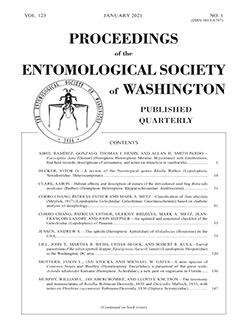Over a 4-year time span (2013–2016), we collected and reared several thousand larvae of the silver-spotted skipper butterfly, Epargyreus clarus (Cramer), from six different commonly used host plants growing at sites in and around the Washington, DC metropolitan area. Of these, more than 1500 survived to pupation or parasitoid emergence, with annual frequencies of parasitism ranging from 1.7–7.6%. More parasitoids tended to emerge from E. clarus larvae collected later in the season, and parasitism varied significantly among host plants. In total we reared six morphologically distinct species of primary parasitoids (all koinobiont endoparasitoids) from E. clarus larvae; these included four species of Braconidae and a single species each of Ichneumonidae and Tachinidae. The braconid Pneumagathis spiracularis (Muesebeck) is reported as a parasitoid of E. clarus for the first time along with the first host plant associations for P. spiracularis. New host plant associations are reported for the ichneumonid Casinaria lamina (Viereck) parasitic on E. clarus. We also report the trigonalid Orthogonalys pulchella (Cresson) as a parasitoid of P. spiracularis along with new host plant associations; P. spiracularis is the first reported host other than a species of Tachinidae and the second record of a trigonalid parasitic on a species of Braconidae. Images of adult parasitoids are provided, and relevant natural history data are presented based on our careful rearing protocol.
How to translate text using browser tools
29 January 2021
Larval Parasitism of the Silver-Spotted Skipper, Epargyreus clarus (Cramer) (Lepidoptera: Hesperiidae), in the Washington, DC Area
John T. Lill,
Martha R. Weiss,
Cedar Block,
Robert R. Kula
ACCESS THE FULL ARTICLE
host plant
Host-parasitoid interactions
phenology
Seasonality





